Emerging Issues In Marketing Communication - Digital Marketing
VerifiedAdded on 2022/01/17
|12
|3448
|26
AI Summary
Contribute Materials
Your contribution can guide someone’s learning journey. Share your
documents today.
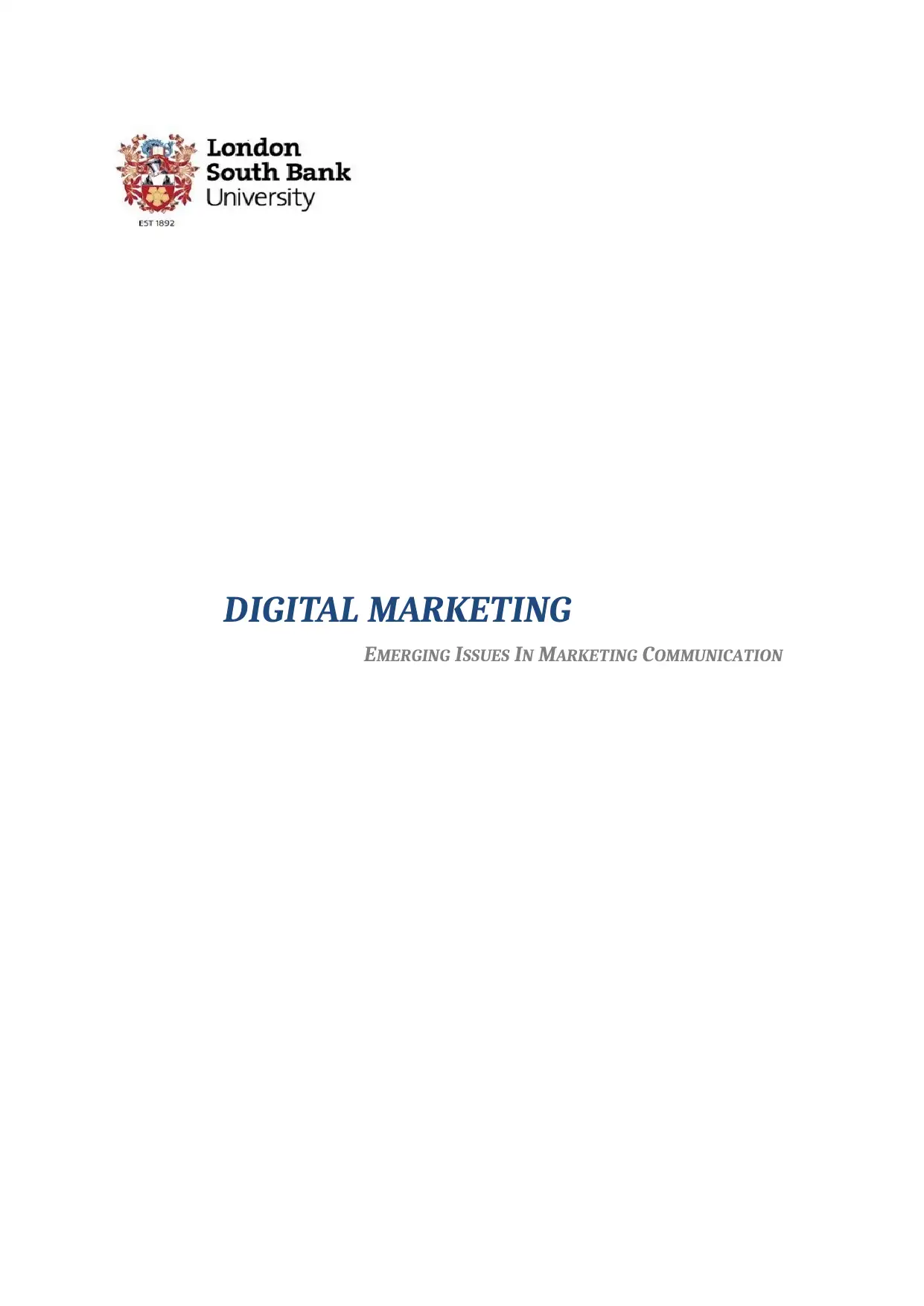
DIGITAL MARKETING
EMERGING ISSUES IN MARKETING COMMUNICATION
EMERGING ISSUES IN MARKETING COMMUNICATION
Secure Best Marks with AI Grader
Need help grading? Try our AI Grader for instant feedback on your assignments.
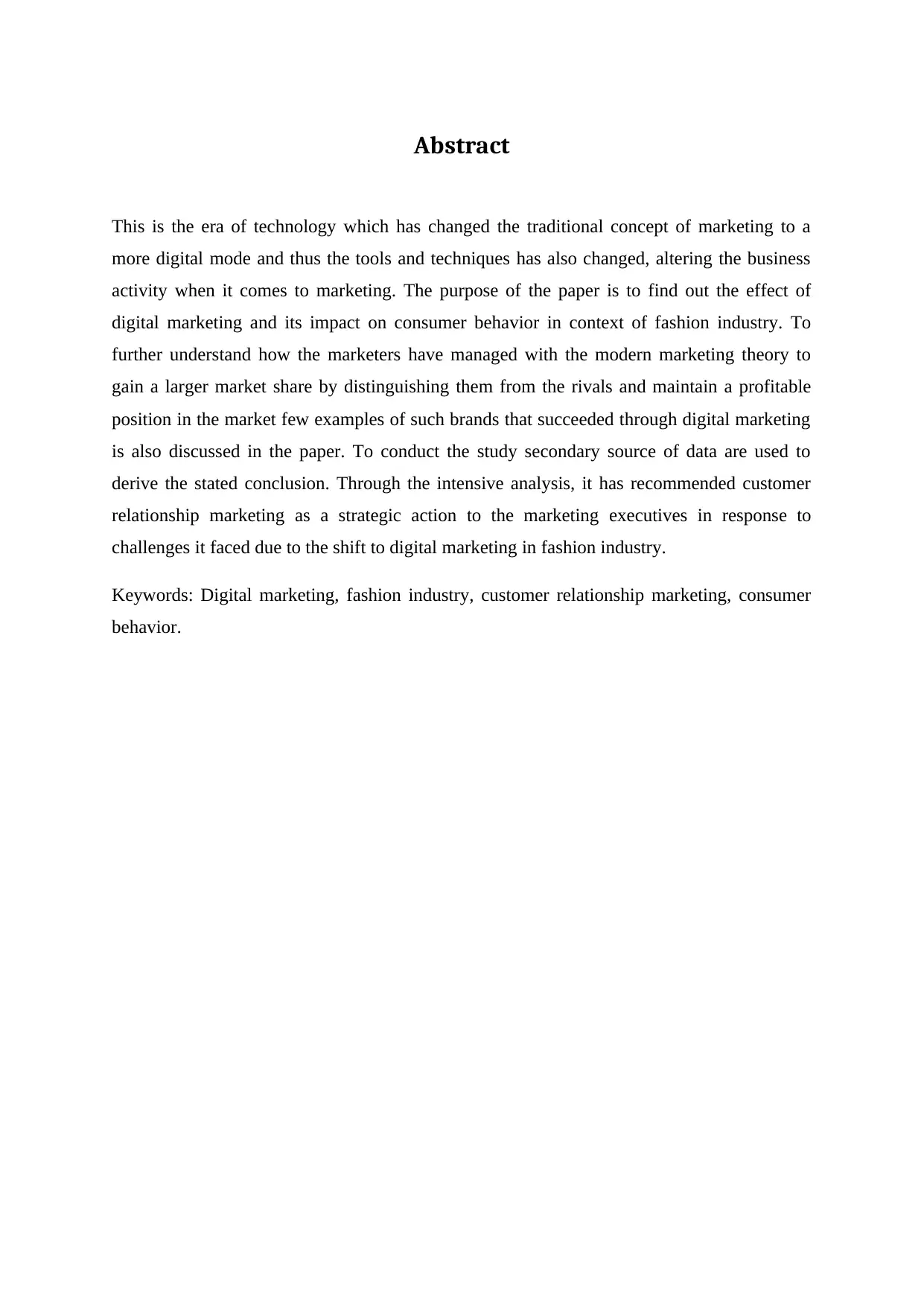
Abstract
This is the era of technology which has changed the traditional concept of marketing to a
more digital mode and thus the tools and techniques has also changed, altering the business
activity when it comes to marketing. The purpose of the paper is to find out the effect of
digital marketing and its impact on consumer behavior in context of fashion industry. To
further understand how the marketers have managed with the modern marketing theory to
gain a larger market share by distinguishing them from the rivals and maintain a profitable
position in the market few examples of such brands that succeeded through digital marketing
is also discussed in the paper. To conduct the study secondary source of data are used to
derive the stated conclusion. Through the intensive analysis, it has recommended customer
relationship marketing as a strategic action to the marketing executives in response to
challenges it faced due to the shift to digital marketing in fashion industry.
Keywords: Digital marketing, fashion industry, customer relationship marketing, consumer
behavior.
This is the era of technology which has changed the traditional concept of marketing to a
more digital mode and thus the tools and techniques has also changed, altering the business
activity when it comes to marketing. The purpose of the paper is to find out the effect of
digital marketing and its impact on consumer behavior in context of fashion industry. To
further understand how the marketers have managed with the modern marketing theory to
gain a larger market share by distinguishing them from the rivals and maintain a profitable
position in the market few examples of such brands that succeeded through digital marketing
is also discussed in the paper. To conduct the study secondary source of data are used to
derive the stated conclusion. Through the intensive analysis, it has recommended customer
relationship marketing as a strategic action to the marketing executives in response to
challenges it faced due to the shift to digital marketing in fashion industry.
Keywords: Digital marketing, fashion industry, customer relationship marketing, consumer
behavior.
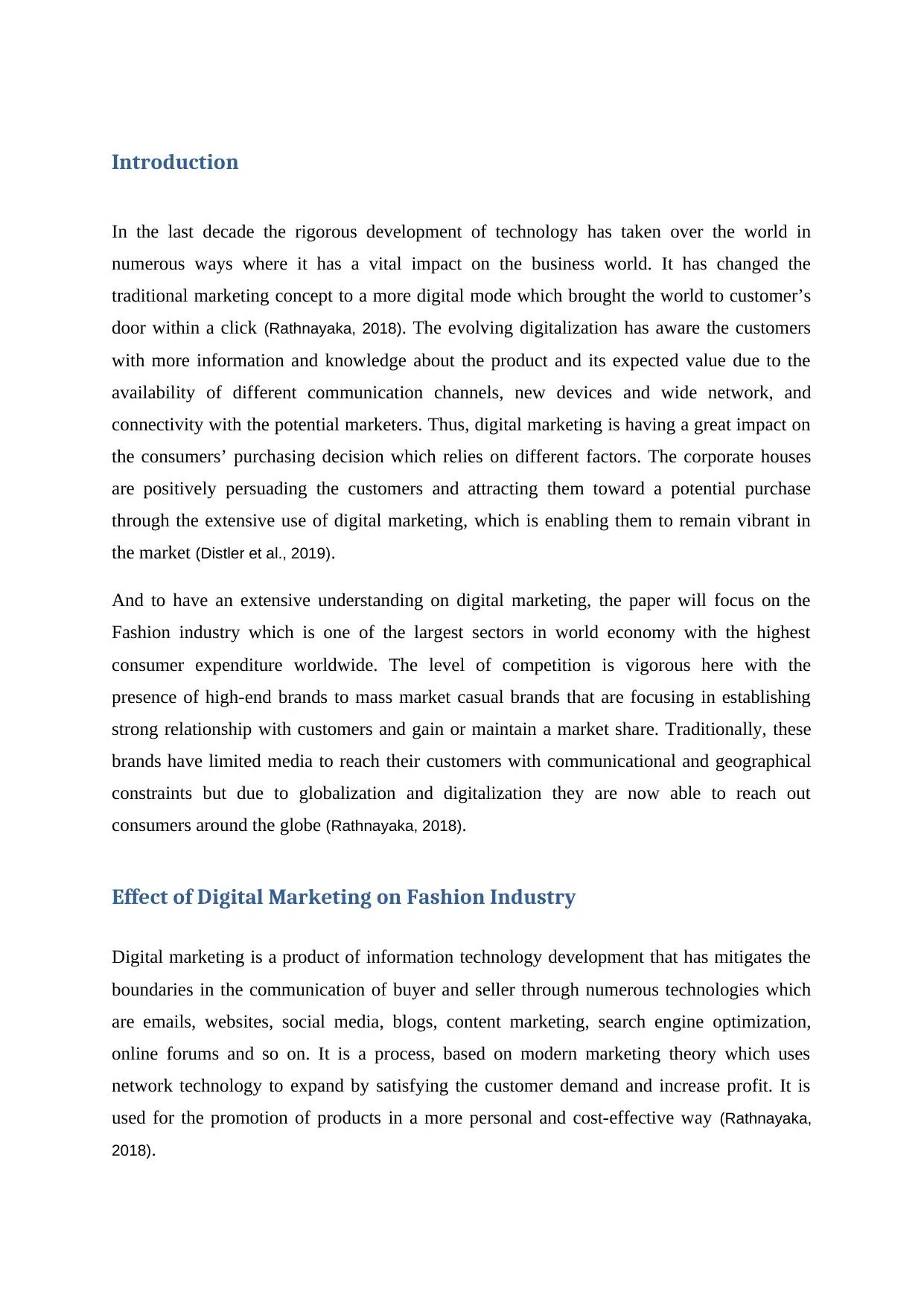
Introduction
In the last decade the rigorous development of technology has taken over the world in
numerous ways where it has a vital impact on the business world. It has changed the
traditional marketing concept to a more digital mode which brought the world to customer’s
door within a click (Rathnayaka, 2018). The evolving digitalization has aware the customers
with more information and knowledge about the product and its expected value due to the
availability of different communication channels, new devices and wide network, and
connectivity with the potential marketers. Thus, digital marketing is having a great impact on
the consumers’ purchasing decision which relies on different factors. The corporate houses
are positively persuading the customers and attracting them toward a potential purchase
through the extensive use of digital marketing, which is enabling them to remain vibrant in
the market (Distler et al., 2019).
And to have an extensive understanding on digital marketing, the paper will focus on the
Fashion industry which is one of the largest sectors in world economy with the highest
consumer expenditure worldwide. The level of competition is vigorous here with the
presence of high-end brands to mass market casual brands that are focusing in establishing
strong relationship with customers and gain or maintain a market share. Traditionally, these
brands have limited media to reach their customers with communicational and geographical
constraints but due to globalization and digitalization they are now able to reach out
consumers around the globe (Rathnayaka, 2018).
Effect of Digital Marketing on Fashion Industry
Digital marketing is a product of information technology development that has mitigates the
boundaries in the communication of buyer and seller through numerous technologies which
are emails, websites, social media, blogs, content marketing, search engine optimization,
online forums and so on. It is a process, based on modern marketing theory which uses
network technology to expand by satisfying the customer demand and increase profit. It is
used for the promotion of products in a more personal and cost-effective way (Rathnayaka,
2018).
In the last decade the rigorous development of technology has taken over the world in
numerous ways where it has a vital impact on the business world. It has changed the
traditional marketing concept to a more digital mode which brought the world to customer’s
door within a click (Rathnayaka, 2018). The evolving digitalization has aware the customers
with more information and knowledge about the product and its expected value due to the
availability of different communication channels, new devices and wide network, and
connectivity with the potential marketers. Thus, digital marketing is having a great impact on
the consumers’ purchasing decision which relies on different factors. The corporate houses
are positively persuading the customers and attracting them toward a potential purchase
through the extensive use of digital marketing, which is enabling them to remain vibrant in
the market (Distler et al., 2019).
And to have an extensive understanding on digital marketing, the paper will focus on the
Fashion industry which is one of the largest sectors in world economy with the highest
consumer expenditure worldwide. The level of competition is vigorous here with the
presence of high-end brands to mass market casual brands that are focusing in establishing
strong relationship with customers and gain or maintain a market share. Traditionally, these
brands have limited media to reach their customers with communicational and geographical
constraints but due to globalization and digitalization they are now able to reach out
consumers around the globe (Rathnayaka, 2018).
Effect of Digital Marketing on Fashion Industry
Digital marketing is a product of information technology development that has mitigates the
boundaries in the communication of buyer and seller through numerous technologies which
are emails, websites, social media, blogs, content marketing, search engine optimization,
online forums and so on. It is a process, based on modern marketing theory which uses
network technology to expand by satisfying the customer demand and increase profit. It is
used for the promotion of products in a more personal and cost-effective way (Rathnayaka,
2018).
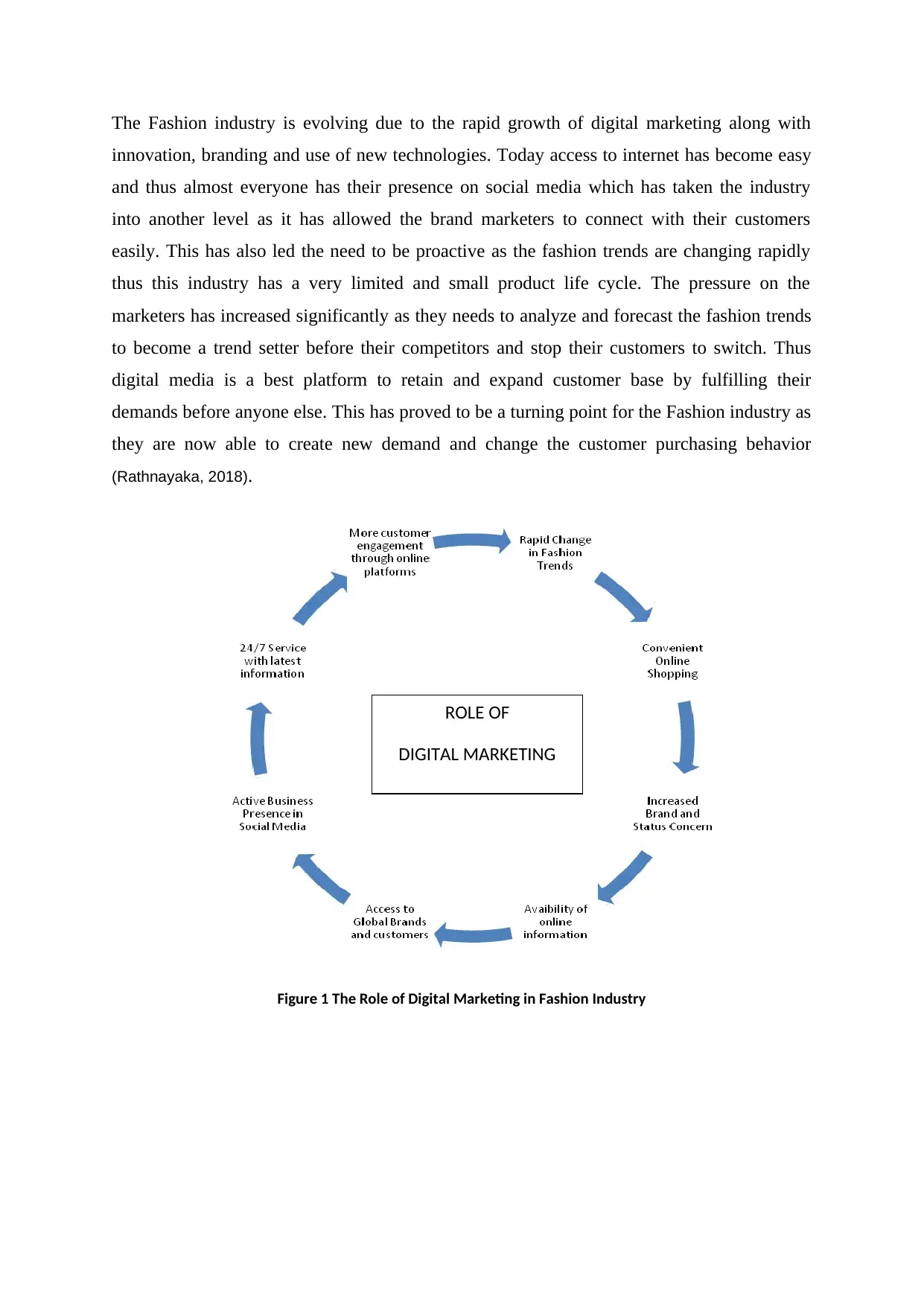
ROLE OF
DIGITAL MARKETING
The Fashion industry is evolving due to the rapid growth of digital marketing along with
innovation, branding and use of new technologies. Today access to internet has become easy
and thus almost everyone has their presence on social media which has taken the industry
into another level as it has allowed the brand marketers to connect with their customers
easily. This has also led the need to be proactive as the fashion trends are changing rapidly
thus this industry has a very limited and small product life cycle. The pressure on the
marketers has increased significantly as they needs to analyze and forecast the fashion trends
to become a trend setter before their competitors and stop their customers to switch. Thus
digital media is a best platform to retain and expand customer base by fulfilling their
demands before anyone else. This has proved to be a turning point for the Fashion industry as
they are now able to create new demand and change the customer purchasing behavior
(Rathnayaka, 2018).
Figure 1 The Role of Digital Marketing in Fashion Industry
DIGITAL MARKETING
The Fashion industry is evolving due to the rapid growth of digital marketing along with
innovation, branding and use of new technologies. Today access to internet has become easy
and thus almost everyone has their presence on social media which has taken the industry
into another level as it has allowed the brand marketers to connect with their customers
easily. This has also led the need to be proactive as the fashion trends are changing rapidly
thus this industry has a very limited and small product life cycle. The pressure on the
marketers has increased significantly as they needs to analyze and forecast the fashion trends
to become a trend setter before their competitors and stop their customers to switch. Thus
digital media is a best platform to retain and expand customer base by fulfilling their
demands before anyone else. This has proved to be a turning point for the Fashion industry as
they are now able to create new demand and change the customer purchasing behavior
(Rathnayaka, 2018).
Figure 1 The Role of Digital Marketing in Fashion Industry
Secure Best Marks with AI Grader
Need help grading? Try our AI Grader for instant feedback on your assignments.
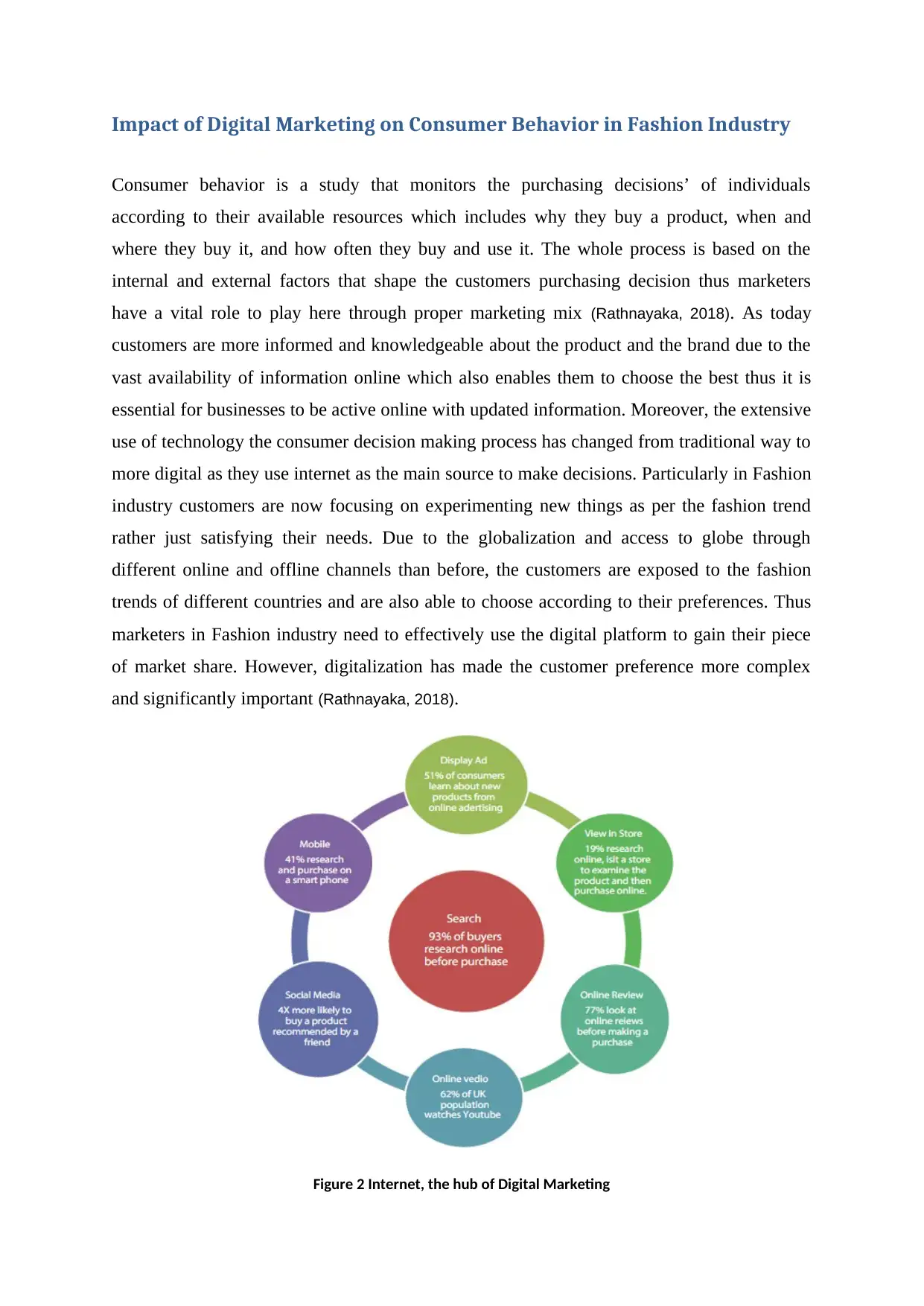
Impact of Digital Marketing on Consumer Behavior in Fashion Industry
Consumer behavior is a study that monitors the purchasing decisions’ of individuals
according to their available resources which includes why they buy a product, when and
where they buy it, and how often they buy and use it. The whole process is based on the
internal and external factors that shape the customers purchasing decision thus marketers
have a vital role to play here through proper marketing mix (Rathnayaka, 2018). As today
customers are more informed and knowledgeable about the product and the brand due to the
vast availability of information online which also enables them to choose the best thus it is
essential for businesses to be active online with updated information. Moreover, the extensive
use of technology the consumer decision making process has changed from traditional way to
more digital as they use internet as the main source to make decisions. Particularly in Fashion
industry customers are now focusing on experimenting new things as per the fashion trend
rather just satisfying their needs. Due to the globalization and access to globe through
different online and offline channels than before, the customers are exposed to the fashion
trends of different countries and are also able to choose according to their preferences. Thus
marketers in Fashion industry need to effectively use the digital platform to gain their piece
of market share. However, digitalization has made the customer preference more complex
and significantly important (Rathnayaka, 2018).
Figure 2 Internet, the hub of Digital Marketing
Consumer behavior is a study that monitors the purchasing decisions’ of individuals
according to their available resources which includes why they buy a product, when and
where they buy it, and how often they buy and use it. The whole process is based on the
internal and external factors that shape the customers purchasing decision thus marketers
have a vital role to play here through proper marketing mix (Rathnayaka, 2018). As today
customers are more informed and knowledgeable about the product and the brand due to the
vast availability of information online which also enables them to choose the best thus it is
essential for businesses to be active online with updated information. Moreover, the extensive
use of technology the consumer decision making process has changed from traditional way to
more digital as they use internet as the main source to make decisions. Particularly in Fashion
industry customers are now focusing on experimenting new things as per the fashion trend
rather just satisfying their needs. Due to the globalization and access to globe through
different online and offline channels than before, the customers are exposed to the fashion
trends of different countries and are also able to choose according to their preferences. Thus
marketers in Fashion industry need to effectively use the digital platform to gain their piece
of market share. However, digitalization has made the customer preference more complex
and significantly important (Rathnayaka, 2018).
Figure 2 Internet, the hub of Digital Marketing
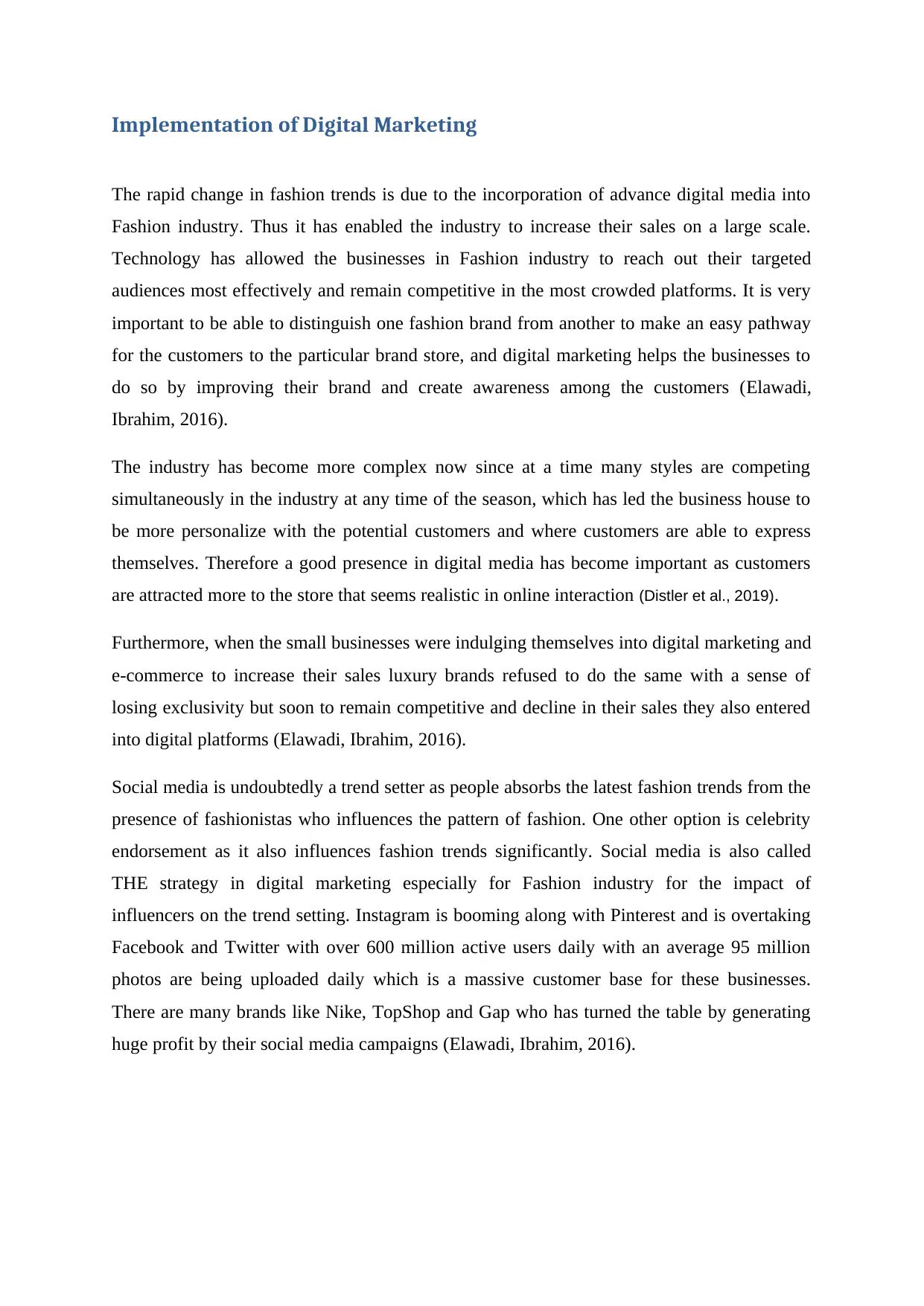
Implementation of Digital Marketing
The rapid change in fashion trends is due to the incorporation of advance digital media into
Fashion industry. Thus it has enabled the industry to increase their sales on a large scale.
Technology has allowed the businesses in Fashion industry to reach out their targeted
audiences most effectively and remain competitive in the most crowded platforms. It is very
important to be able to distinguish one fashion brand from another to make an easy pathway
for the customers to the particular brand store, and digital marketing helps the businesses to
do so by improving their brand and create awareness among the customers (Elawadi,
Ibrahim, 2016).
The industry has become more complex now since at a time many styles are competing
simultaneously in the industry at any time of the season, which has led the business house to
be more personalize with the potential customers and where customers are able to express
themselves. Therefore a good presence in digital media has become important as customers
are attracted more to the store that seems realistic in online interaction (Distler et al., 2019).
Furthermore, when the small businesses were indulging themselves into digital marketing and
e-commerce to increase their sales luxury brands refused to do the same with a sense of
losing exclusivity but soon to remain competitive and decline in their sales they also entered
into digital platforms (Elawadi, Ibrahim, 2016).
Social media is undoubtedly a trend setter as people absorbs the latest fashion trends from the
presence of fashionistas who influences the pattern of fashion. One other option is celebrity
endorsement as it also influences fashion trends significantly. Social media is also called
THE strategy in digital marketing especially for Fashion industry for the impact of
influencers on the trend setting. Instagram is booming along with Pinterest and is overtaking
Facebook and Twitter with over 600 million active users daily with an average 95 million
photos are being uploaded daily which is a massive customer base for these businesses.
There are many brands like Nike, TopShop and Gap who has turned the table by generating
huge profit by their social media campaigns (Elawadi, Ibrahim, 2016).
The rapid change in fashion trends is due to the incorporation of advance digital media into
Fashion industry. Thus it has enabled the industry to increase their sales on a large scale.
Technology has allowed the businesses in Fashion industry to reach out their targeted
audiences most effectively and remain competitive in the most crowded platforms. It is very
important to be able to distinguish one fashion brand from another to make an easy pathway
for the customers to the particular brand store, and digital marketing helps the businesses to
do so by improving their brand and create awareness among the customers (Elawadi,
Ibrahim, 2016).
The industry has become more complex now since at a time many styles are competing
simultaneously in the industry at any time of the season, which has led the business house to
be more personalize with the potential customers and where customers are able to express
themselves. Therefore a good presence in digital media has become important as customers
are attracted more to the store that seems realistic in online interaction (Distler et al., 2019).
Furthermore, when the small businesses were indulging themselves into digital marketing and
e-commerce to increase their sales luxury brands refused to do the same with a sense of
losing exclusivity but soon to remain competitive and decline in their sales they also entered
into digital platforms (Elawadi, Ibrahim, 2016).
Social media is undoubtedly a trend setter as people absorbs the latest fashion trends from the
presence of fashionistas who influences the pattern of fashion. One other option is celebrity
endorsement as it also influences fashion trends significantly. Social media is also called
THE strategy in digital marketing especially for Fashion industry for the impact of
influencers on the trend setting. Instagram is booming along with Pinterest and is overtaking
Facebook and Twitter with over 600 million active users daily with an average 95 million
photos are being uploaded daily which is a massive customer base for these businesses.
There are many brands like Nike, TopShop and Gap who has turned the table by generating
huge profit by their social media campaigns (Elawadi, Ibrahim, 2016).
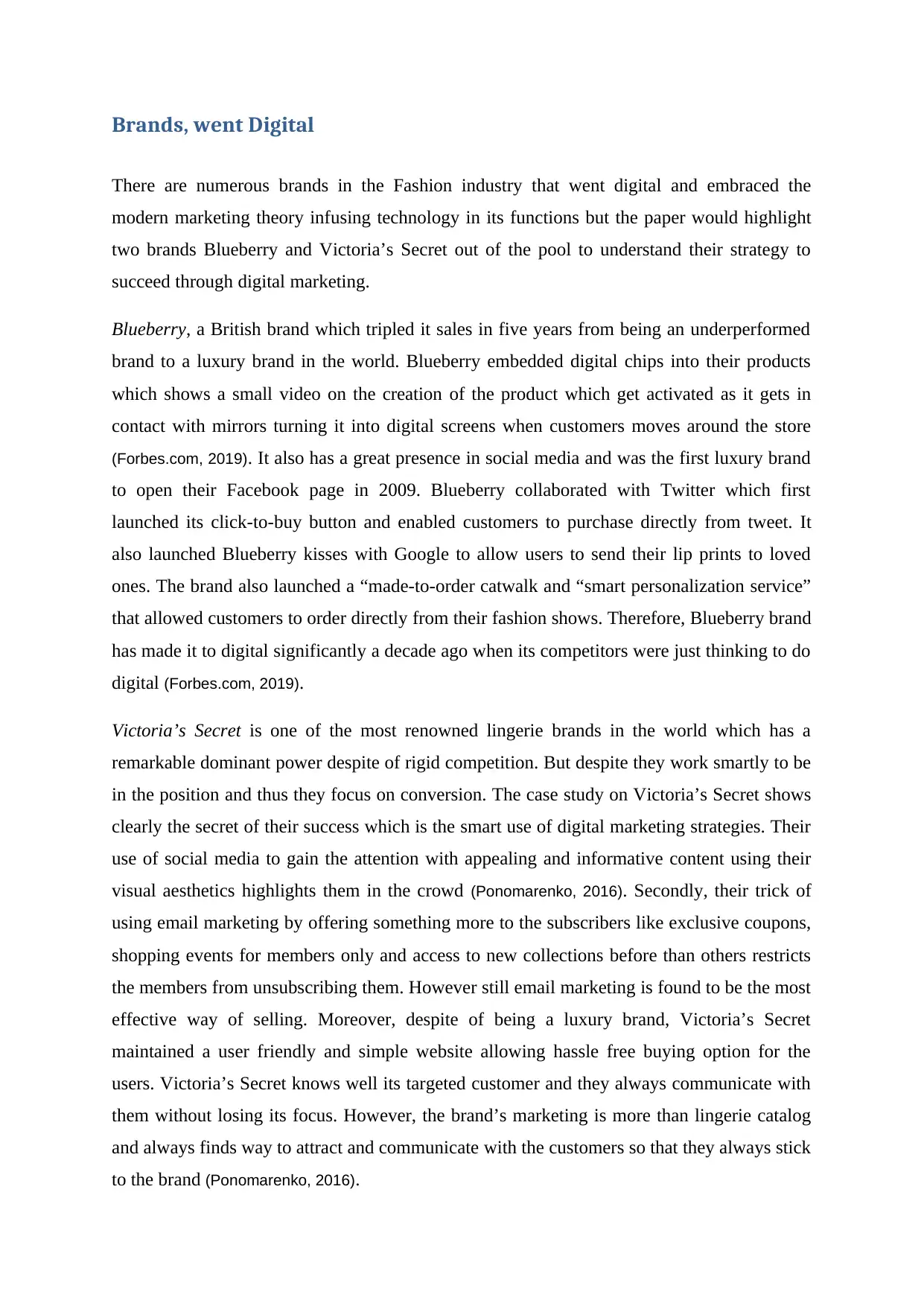
Brands, went Digital
There are numerous brands in the Fashion industry that went digital and embraced the
modern marketing theory infusing technology in its functions but the paper would highlight
two brands Blueberry and Victoria’s Secret out of the pool to understand their strategy to
succeed through digital marketing.
Blueberry, a British brand which tripled it sales in five years from being an underperformed
brand to a luxury brand in the world. Blueberry embedded digital chips into their products
which shows a small video on the creation of the product which get activated as it gets in
contact with mirrors turning it into digital screens when customers moves around the store
(Forbes.com, 2019). It also has a great presence in social media and was the first luxury brand
to open their Facebook page in 2009. Blueberry collaborated with Twitter which first
launched its click-to-buy button and enabled customers to purchase directly from tweet. It
also launched Blueberry kisses with Google to allow users to send their lip prints to loved
ones. The brand also launched a “made-to-order catwalk and “smart personalization service”
that allowed customers to order directly from their fashion shows. Therefore, Blueberry brand
has made it to digital significantly a decade ago when its competitors were just thinking to do
digital (Forbes.com, 2019).
Victoria’s Secret is one of the most renowned lingerie brands in the world which has a
remarkable dominant power despite of rigid competition. But despite they work smartly to be
in the position and thus they focus on conversion. The case study on Victoria’s Secret shows
clearly the secret of their success which is the smart use of digital marketing strategies. Their
use of social media to gain the attention with appealing and informative content using their
visual aesthetics highlights them in the crowd (Ponomarenko, 2016). Secondly, their trick of
using email marketing by offering something more to the subscribers like exclusive coupons,
shopping events for members only and access to new collections before than others restricts
the members from unsubscribing them. However still email marketing is found to be the most
effective way of selling. Moreover, despite of being a luxury brand, Victoria’s Secret
maintained a user friendly and simple website allowing hassle free buying option for the
users. Victoria’s Secret knows well its targeted customer and they always communicate with
them without losing its focus. However, the brand’s marketing is more than lingerie catalog
and always finds way to attract and communicate with the customers so that they always stick
to the brand (Ponomarenko, 2016).
There are numerous brands in the Fashion industry that went digital and embraced the
modern marketing theory infusing technology in its functions but the paper would highlight
two brands Blueberry and Victoria’s Secret out of the pool to understand their strategy to
succeed through digital marketing.
Blueberry, a British brand which tripled it sales in five years from being an underperformed
brand to a luxury brand in the world. Blueberry embedded digital chips into their products
which shows a small video on the creation of the product which get activated as it gets in
contact with mirrors turning it into digital screens when customers moves around the store
(Forbes.com, 2019). It also has a great presence in social media and was the first luxury brand
to open their Facebook page in 2009. Blueberry collaborated with Twitter which first
launched its click-to-buy button and enabled customers to purchase directly from tweet. It
also launched Blueberry kisses with Google to allow users to send their lip prints to loved
ones. The brand also launched a “made-to-order catwalk and “smart personalization service”
that allowed customers to order directly from their fashion shows. Therefore, Blueberry brand
has made it to digital significantly a decade ago when its competitors were just thinking to do
digital (Forbes.com, 2019).
Victoria’s Secret is one of the most renowned lingerie brands in the world which has a
remarkable dominant power despite of rigid competition. But despite they work smartly to be
in the position and thus they focus on conversion. The case study on Victoria’s Secret shows
clearly the secret of their success which is the smart use of digital marketing strategies. Their
use of social media to gain the attention with appealing and informative content using their
visual aesthetics highlights them in the crowd (Ponomarenko, 2016). Secondly, their trick of
using email marketing by offering something more to the subscribers like exclusive coupons,
shopping events for members only and access to new collections before than others restricts
the members from unsubscribing them. However still email marketing is found to be the most
effective way of selling. Moreover, despite of being a luxury brand, Victoria’s Secret
maintained a user friendly and simple website allowing hassle free buying option for the
users. Victoria’s Secret knows well its targeted customer and they always communicate with
them without losing its focus. However, the brand’s marketing is more than lingerie catalog
and always finds way to attract and communicate with the customers so that they always stick
to the brand (Ponomarenko, 2016).
Paraphrase This Document
Need a fresh take? Get an instant paraphrase of this document with our AI Paraphraser
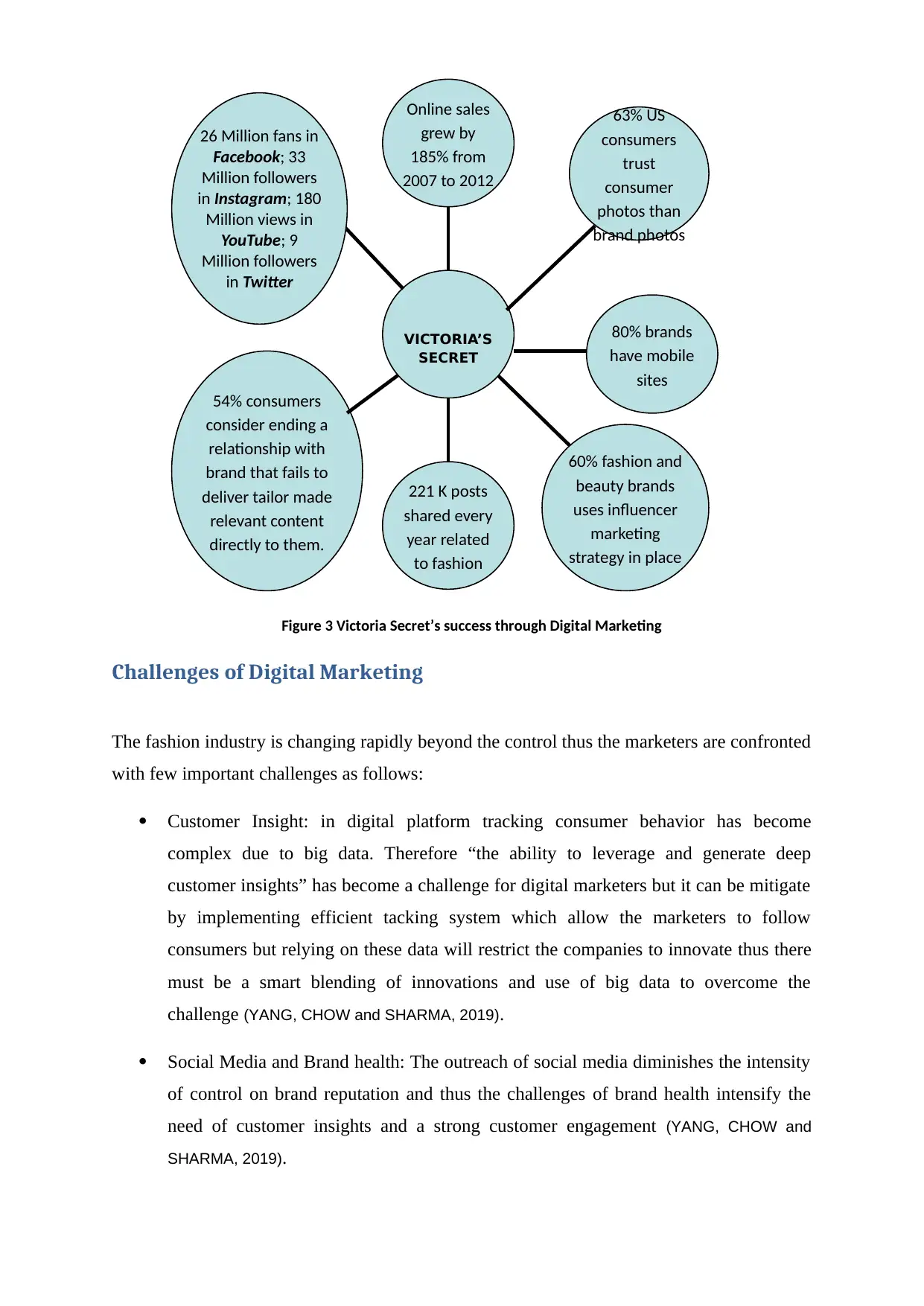
Challenges of Digital Marketing
The fashion industry is changing rapidly beyond the control thus the marketers are confronted
with few important challenges as follows:
Customer Insight: in digital platform tracking consumer behavior has become
complex due to big data. Therefore “the ability to leverage and generate deep
customer insights” has become a challenge for digital marketers but it can be mitigate
by implementing efficient tacking system which allow the marketers to follow
consumers but relying on these data will restrict the companies to innovate thus there
must be a smart blending of innovations and use of big data to overcome the
challenge (YANG, CHOW and SHARMA, 2019).
Social Media and Brand health: The outreach of social media diminishes the intensity
of control on brand reputation and thus the challenges of brand health intensify the
need of customer insights and a strong customer engagement (YANG, CHOW and
SHARMA, 2019).
221 K posts
shared every
year related
to fashion
Online sales
grew by
185% from
2007 to 2012
VICTORIA’S
SECRET
63% US
consumers
trust
consumer
photos than
brand photos
80% brands
have mobile
sites
54% consumers
consider ending a
relationship with
brand that fails to
deliver tailor made
relevant content
directly to them.
60% fashion and
beauty brands
uses influencer
marketing
strategy in place
26 Million fans in
Facebook; 33
Million followers
in Instagram; 180
Million views in
YouTube; 9
Million followers
in Twitter
Figure 3 Victoria Secret’s success through Digital Marketing
The fashion industry is changing rapidly beyond the control thus the marketers are confronted
with few important challenges as follows:
Customer Insight: in digital platform tracking consumer behavior has become
complex due to big data. Therefore “the ability to leverage and generate deep
customer insights” has become a challenge for digital marketers but it can be mitigate
by implementing efficient tacking system which allow the marketers to follow
consumers but relying on these data will restrict the companies to innovate thus there
must be a smart blending of innovations and use of big data to overcome the
challenge (YANG, CHOW and SHARMA, 2019).
Social Media and Brand health: The outreach of social media diminishes the intensity
of control on brand reputation and thus the challenges of brand health intensify the
need of customer insights and a strong customer engagement (YANG, CHOW and
SHARMA, 2019).
221 K posts
shared every
year related
to fashion
Online sales
grew by
185% from
2007 to 2012
VICTORIA’S
SECRET
63% US
consumers
trust
consumer
photos than
brand photos
80% brands
have mobile
sites
54% consumers
consider ending a
relationship with
brand that fails to
deliver tailor made
relevant content
directly to them.
60% fashion and
beauty brands
uses influencer
marketing
strategy in place
26 Million fans in
Facebook; 33
Million followers
in Instagram; 180
Million views in
YouTube; 9
Million followers
in Twitter
Figure 3 Victoria Secret’s success through Digital Marketing
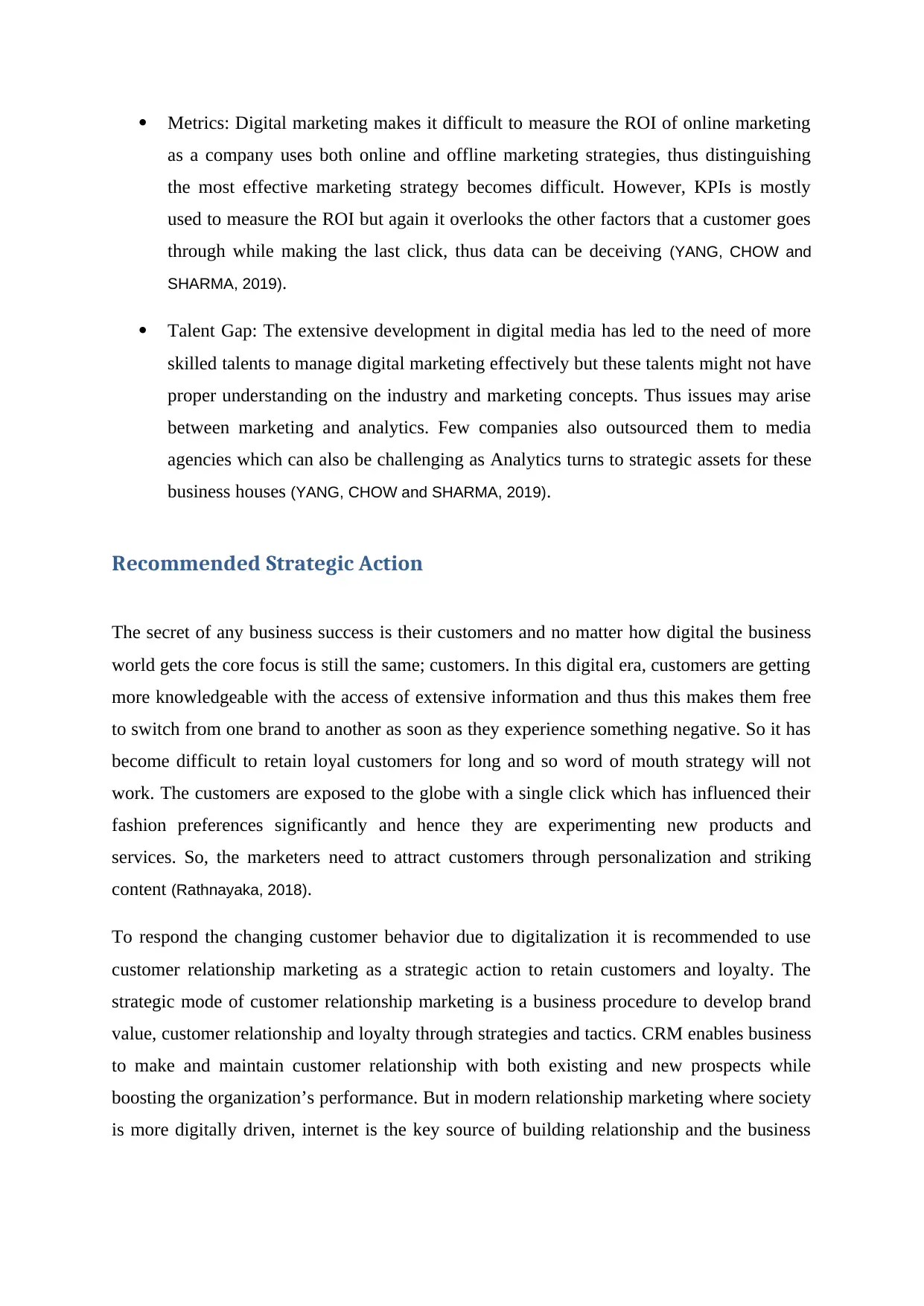
Metrics: Digital marketing makes it difficult to measure the ROI of online marketing
as a company uses both online and offline marketing strategies, thus distinguishing
the most effective marketing strategy becomes difficult. However, KPIs is mostly
used to measure the ROI but again it overlooks the other factors that a customer goes
through while making the last click, thus data can be deceiving (YANG, CHOW and
SHARMA, 2019).
Talent Gap: The extensive development in digital media has led to the need of more
skilled talents to manage digital marketing effectively but these talents might not have
proper understanding on the industry and marketing concepts. Thus issues may arise
between marketing and analytics. Few companies also outsourced them to media
agencies which can also be challenging as Analytics turns to strategic assets for these
business houses (YANG, CHOW and SHARMA, 2019).
Recommended Strategic Action
The secret of any business success is their customers and no matter how digital the business
world gets the core focus is still the same; customers. In this digital era, customers are getting
more knowledgeable with the access of extensive information and thus this makes them free
to switch from one brand to another as soon as they experience something negative. So it has
become difficult to retain loyal customers for long and so word of mouth strategy will not
work. The customers are exposed to the globe with a single click which has influenced their
fashion preferences significantly and hence they are experimenting new products and
services. So, the marketers need to attract customers through personalization and striking
content (Rathnayaka, 2018).
To respond the changing customer behavior due to digitalization it is recommended to use
customer relationship marketing as a strategic action to retain customers and loyalty. The
strategic mode of customer relationship marketing is a business procedure to develop brand
value, customer relationship and loyalty through strategies and tactics. CRM enables business
to make and maintain customer relationship with both existing and new prospects while
boosting the organization’s performance. But in modern relationship marketing where society
is more digitally driven, internet is the key source of building relationship and the business
as a company uses both online and offline marketing strategies, thus distinguishing
the most effective marketing strategy becomes difficult. However, KPIs is mostly
used to measure the ROI but again it overlooks the other factors that a customer goes
through while making the last click, thus data can be deceiving (YANG, CHOW and
SHARMA, 2019).
Talent Gap: The extensive development in digital media has led to the need of more
skilled talents to manage digital marketing effectively but these talents might not have
proper understanding on the industry and marketing concepts. Thus issues may arise
between marketing and analytics. Few companies also outsourced them to media
agencies which can also be challenging as Analytics turns to strategic assets for these
business houses (YANG, CHOW and SHARMA, 2019).
Recommended Strategic Action
The secret of any business success is their customers and no matter how digital the business
world gets the core focus is still the same; customers. In this digital era, customers are getting
more knowledgeable with the access of extensive information and thus this makes them free
to switch from one brand to another as soon as they experience something negative. So it has
become difficult to retain loyal customers for long and so word of mouth strategy will not
work. The customers are exposed to the globe with a single click which has influenced their
fashion preferences significantly and hence they are experimenting new products and
services. So, the marketers need to attract customers through personalization and striking
content (Rathnayaka, 2018).
To respond the changing customer behavior due to digitalization it is recommended to use
customer relationship marketing as a strategic action to retain customers and loyalty. The
strategic mode of customer relationship marketing is a business procedure to develop brand
value, customer relationship and loyalty through strategies and tactics. CRM enables business
to make and maintain customer relationship with both existing and new prospects while
boosting the organization’s performance. But in modern relationship marketing where society
is more digitally driven, internet is the key source of building relationship and the business
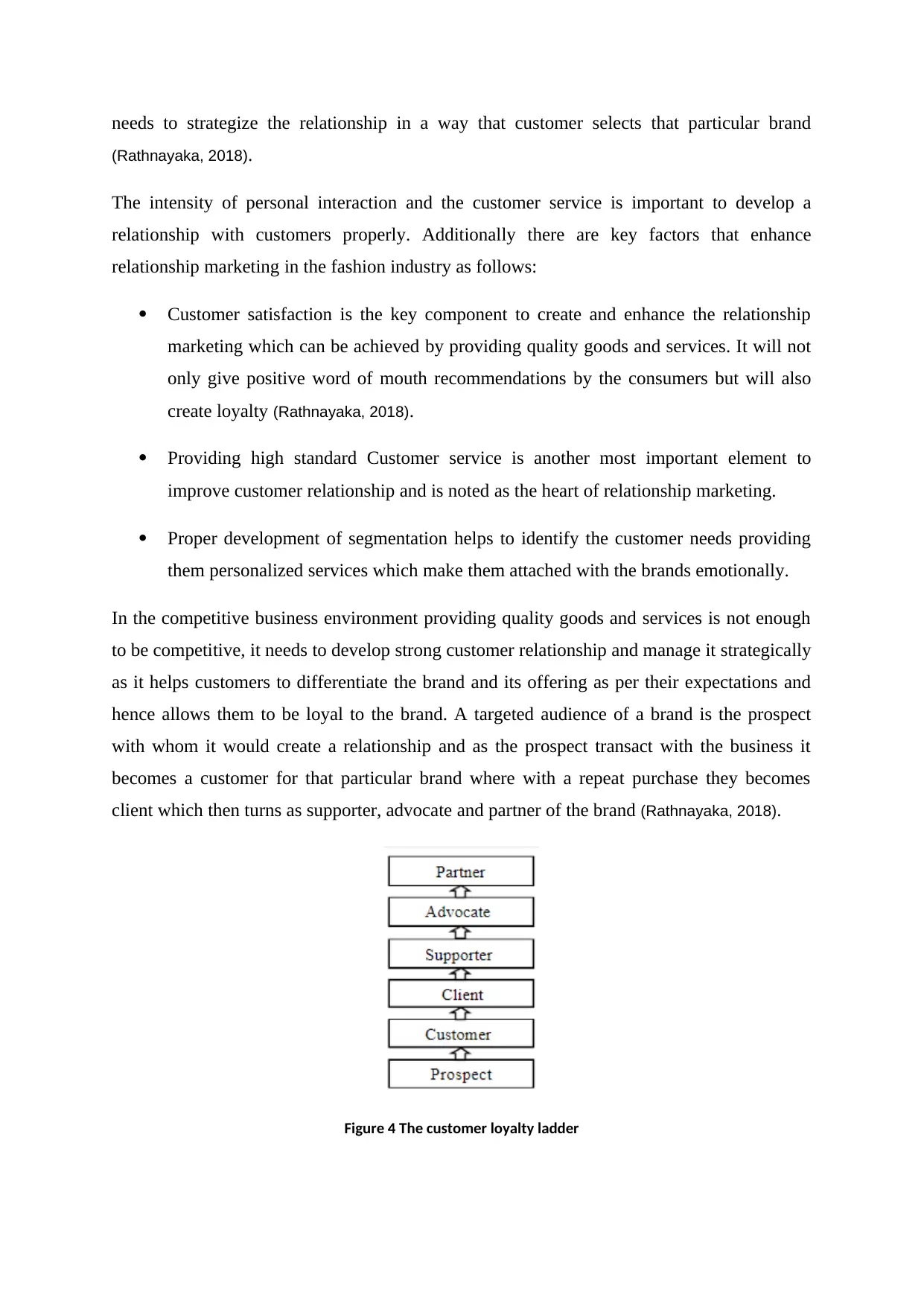
needs to strategize the relationship in a way that customer selects that particular brand
(Rathnayaka, 2018).
The intensity of personal interaction and the customer service is important to develop a
relationship with customers properly. Additionally there are key factors that enhance
relationship marketing in the fashion industry as follows:
Customer satisfaction is the key component to create and enhance the relationship
marketing which can be achieved by providing quality goods and services. It will not
only give positive word of mouth recommendations by the consumers but will also
create loyalty (Rathnayaka, 2018).
Providing high standard Customer service is another most important element to
improve customer relationship and is noted as the heart of relationship marketing.
Proper development of segmentation helps to identify the customer needs providing
them personalized services which make them attached with the brands emotionally.
In the competitive business environment providing quality goods and services is not enough
to be competitive, it needs to develop strong customer relationship and manage it strategically
as it helps customers to differentiate the brand and its offering as per their expectations and
hence allows them to be loyal to the brand. A targeted audience of a brand is the prospect
with whom it would create a relationship and as the prospect transact with the business it
becomes a customer for that particular brand where with a repeat purchase they becomes
client which then turns as supporter, advocate and partner of the brand (Rathnayaka, 2018).
Figure 4 The customer loyalty ladder
(Rathnayaka, 2018).
The intensity of personal interaction and the customer service is important to develop a
relationship with customers properly. Additionally there are key factors that enhance
relationship marketing in the fashion industry as follows:
Customer satisfaction is the key component to create and enhance the relationship
marketing which can be achieved by providing quality goods and services. It will not
only give positive word of mouth recommendations by the consumers but will also
create loyalty (Rathnayaka, 2018).
Providing high standard Customer service is another most important element to
improve customer relationship and is noted as the heart of relationship marketing.
Proper development of segmentation helps to identify the customer needs providing
them personalized services which make them attached with the brands emotionally.
In the competitive business environment providing quality goods and services is not enough
to be competitive, it needs to develop strong customer relationship and manage it strategically
as it helps customers to differentiate the brand and its offering as per their expectations and
hence allows them to be loyal to the brand. A targeted audience of a brand is the prospect
with whom it would create a relationship and as the prospect transact with the business it
becomes a customer for that particular brand where with a repeat purchase they becomes
client which then turns as supporter, advocate and partner of the brand (Rathnayaka, 2018).
Figure 4 The customer loyalty ladder
Secure Best Marks with AI Grader
Need help grading? Try our AI Grader for instant feedback on your assignments.
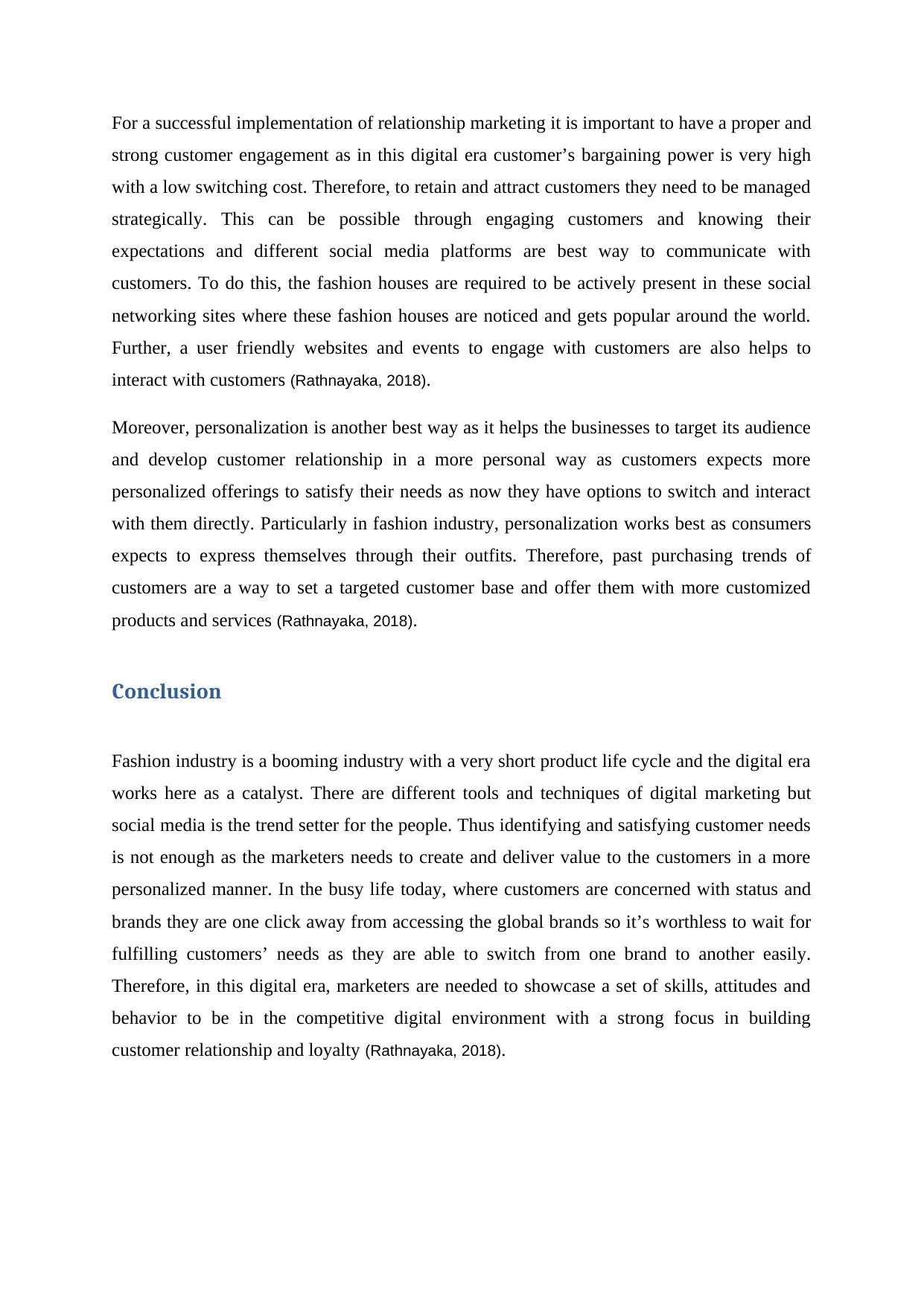
For a successful implementation of relationship marketing it is important to have a proper and
strong customer engagement as in this digital era customer’s bargaining power is very high
with a low switching cost. Therefore, to retain and attract customers they need to be managed
strategically. This can be possible through engaging customers and knowing their
expectations and different social media platforms are best way to communicate with
customers. To do this, the fashion houses are required to be actively present in these social
networking sites where these fashion houses are noticed and gets popular around the world.
Further, a user friendly websites and events to engage with customers are also helps to
interact with customers (Rathnayaka, 2018).
Moreover, personalization is another best way as it helps the businesses to target its audience
and develop customer relationship in a more personal way as customers expects more
personalized offerings to satisfy their needs as now they have options to switch and interact
with them directly. Particularly in fashion industry, personalization works best as consumers
expects to express themselves through their outfits. Therefore, past purchasing trends of
customers are a way to set a targeted customer base and offer them with more customized
products and services (Rathnayaka, 2018).
Conclusion
Fashion industry is a booming industry with a very short product life cycle and the digital era
works here as a catalyst. There are different tools and techniques of digital marketing but
social media is the trend setter for the people. Thus identifying and satisfying customer needs
is not enough as the marketers needs to create and deliver value to the customers in a more
personalized manner. In the busy life today, where customers are concerned with status and
brands they are one click away from accessing the global brands so it’s worthless to wait for
fulfilling customers’ needs as they are able to switch from one brand to another easily.
Therefore, in this digital era, marketers are needed to showcase a set of skills, attitudes and
behavior to be in the competitive digital environment with a strong focus in building
customer relationship and loyalty (Rathnayaka, 2018).
strong customer engagement as in this digital era customer’s bargaining power is very high
with a low switching cost. Therefore, to retain and attract customers they need to be managed
strategically. This can be possible through engaging customers and knowing their
expectations and different social media platforms are best way to communicate with
customers. To do this, the fashion houses are required to be actively present in these social
networking sites where these fashion houses are noticed and gets popular around the world.
Further, a user friendly websites and events to engage with customers are also helps to
interact with customers (Rathnayaka, 2018).
Moreover, personalization is another best way as it helps the businesses to target its audience
and develop customer relationship in a more personal way as customers expects more
personalized offerings to satisfy their needs as now they have options to switch and interact
with them directly. Particularly in fashion industry, personalization works best as consumers
expects to express themselves through their outfits. Therefore, past purchasing trends of
customers are a way to set a targeted customer base and offer them with more customized
products and services (Rathnayaka, 2018).
Conclusion
Fashion industry is a booming industry with a very short product life cycle and the digital era
works here as a catalyst. There are different tools and techniques of digital marketing but
social media is the trend setter for the people. Thus identifying and satisfying customer needs
is not enough as the marketers needs to create and deliver value to the customers in a more
personalized manner. In the busy life today, where customers are concerned with status and
brands they are one click away from accessing the global brands so it’s worthless to wait for
fulfilling customers’ needs as they are able to switch from one brand to another easily.
Therefore, in this digital era, marketers are needed to showcase a set of skills, attitudes and
behavior to be in the competitive digital environment with a strong focus in building
customer relationship and loyalty (Rathnayaka, 2018).
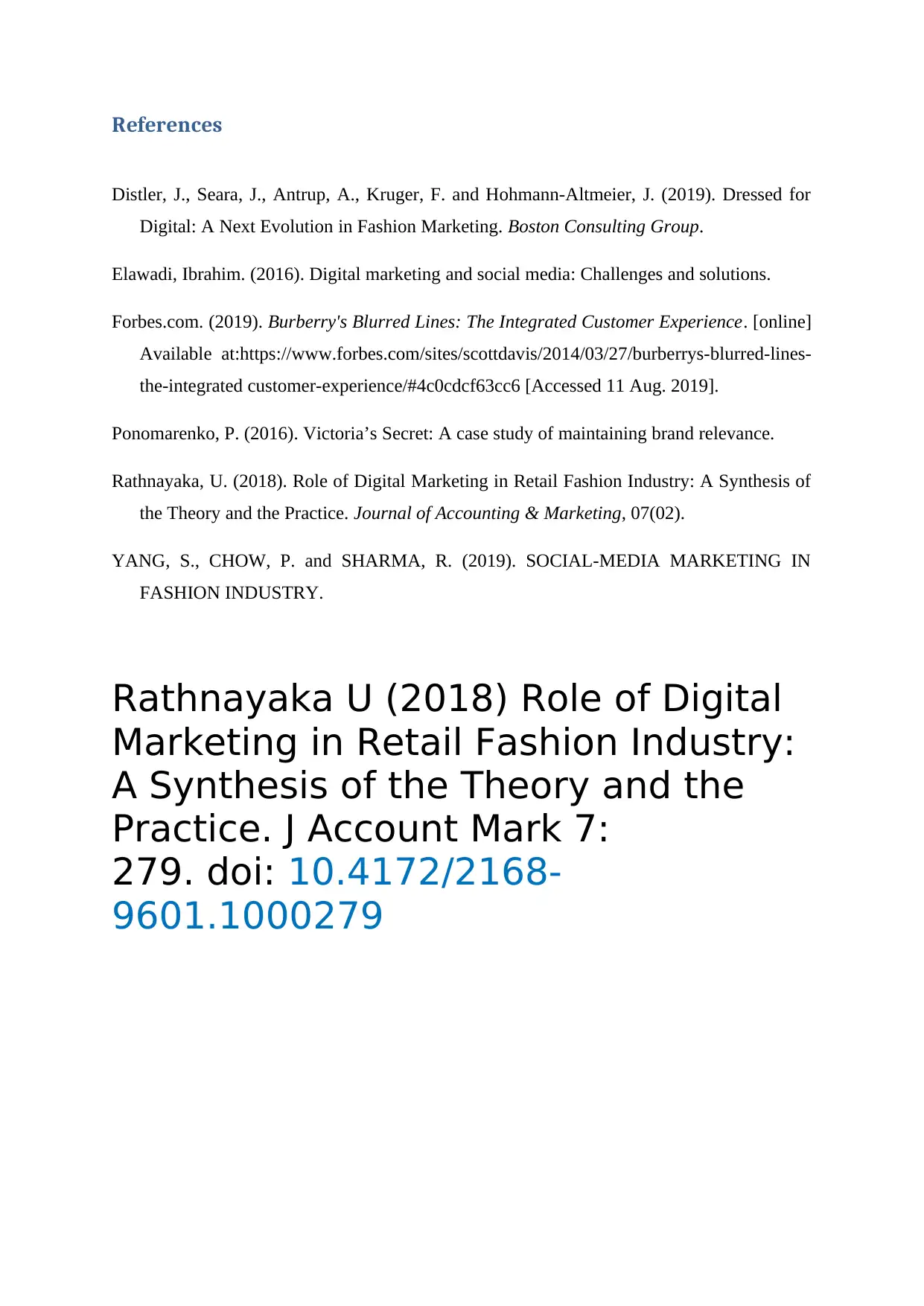
References
Distler, J., Seara, J., Antrup, A., Kruger, F. and Hohmann-Altmeier, J. (2019). Dressed for
Digital: A Next Evolution in Fashion Marketing. Boston Consulting Group.
Elawadi, Ibrahim. (2016). Digital marketing and social media: Challenges and solutions.
Forbes.com. (2019). Burberry's Blurred Lines: The Integrated Customer Experience. [online]
Available at:https://www.forbes.com/sites/scottdavis/2014/03/27/burberrys-blurred-lines-
the-integrated customer-experience/#4c0cdcf63cc6 [Accessed 11 Aug. 2019].
Ponomarenko, P. (2016). Victoria’s Secret: A case study of maintaining brand relevance.
Rathnayaka, U. (2018). Role of Digital Marketing in Retail Fashion Industry: A Synthesis of
the Theory and the Practice. Journal of Accounting & Marketing, 07(02).
YANG, S., CHOW, P. and SHARMA, R. (2019). SOCIAL-MEDIA MARKETING IN
FASHION INDUSTRY.
Rathnayaka U (2018) Role of Digital
Marketing in Retail Fashion Industry:
A Synthesis of the Theory and the
Practice. J Account Mark 7:
279. doi: 10.4172/2168-
9601.1000279
Distler, J., Seara, J., Antrup, A., Kruger, F. and Hohmann-Altmeier, J. (2019). Dressed for
Digital: A Next Evolution in Fashion Marketing. Boston Consulting Group.
Elawadi, Ibrahim. (2016). Digital marketing and social media: Challenges and solutions.
Forbes.com. (2019). Burberry's Blurred Lines: The Integrated Customer Experience. [online]
Available at:https://www.forbes.com/sites/scottdavis/2014/03/27/burberrys-blurred-lines-
the-integrated customer-experience/#4c0cdcf63cc6 [Accessed 11 Aug. 2019].
Ponomarenko, P. (2016). Victoria’s Secret: A case study of maintaining brand relevance.
Rathnayaka, U. (2018). Role of Digital Marketing in Retail Fashion Industry: A Synthesis of
the Theory and the Practice. Journal of Accounting & Marketing, 07(02).
YANG, S., CHOW, P. and SHARMA, R. (2019). SOCIAL-MEDIA MARKETING IN
FASHION INDUSTRY.
Rathnayaka U (2018) Role of Digital
Marketing in Retail Fashion Industry:
A Synthesis of the Theory and the
Practice. J Account Mark 7:
279. doi: 10.4172/2168-
9601.1000279
1 out of 12
Related Documents
Your All-in-One AI-Powered Toolkit for Academic Success.
+13062052269
info@desklib.com
Available 24*7 on WhatsApp / Email
![[object Object]](/_next/static/media/star-bottom.7253800d.svg)
Unlock your academic potential
© 2024 | Zucol Services PVT LTD | All rights reserved.


